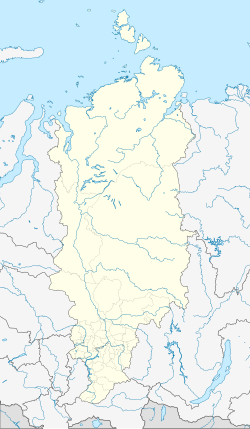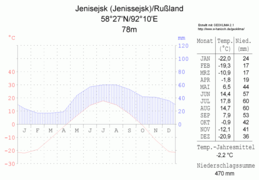Yenisseisk
| city
Yeniseisk
Енисейск
|
||||||||||||||||||||||||||||||||||||||||||
|
||||||||||||||||||||||||||||||||||||||||||
|
||||||||||||||||||||||||||||||||||||||||||
| List of cities in Russia | ||||||||||||||||||||||||||||||||||||||||||
Yeniseisk ( Russian Енисейск ) is a city with 18,766 inhabitants (as of October 14, 2010) in the Krasnoyarsk region in Russia , on the banks of the Yenisei . She is often referred to as the father of Siberian cities because of her age .
history
Yeniseisk was founded in 1619 as a military fortress for the settlement of Siberia by Cossacks, received city rights in 1676 and became one of the most important trading points in early Siberia for gold and furs. 90% of Russian gold finds were once made in the area, which explains the (once) magnificent stone houses. The city also served as the gateway to Eastern Siberia for a century and a half.

Yenisseisk also became famous for its churches and monasteries. Shortly after the establishment of the Tobolsk-Siberian Diocese in 1620, the Patriarch Filaret Romanov began building churches in Yeniseisk.
The preserved architectural buildings of the city include: The Spasso-Preobrazhensky Monastery (founded 1642), the Apparition Cathedral (1738–1764), Church of the Resurrection (1735–1747), Trinity Church (1772–1776), Uspensky Church (1793–1818 ), the building of the Yeniseisk Regional Museum (1747–1753), the Local History Museum (1883) and others.
Yenisseisk also served as a place of exile from an early stage . Under Stalin , prisoners were shipped to the gulag sites to the north . From 1953, a railway line from Krasnoyarsk to Yeniseisk was to be built.
Population development
| year | Residents |
|---|---|
| 1897 | 11,506 |
| 1939 | 12,764 |
| 1959 | 17,047 |
| 1970 | 19,880 |
| 1979 | 20,798 |
| 1989 | 22,891 |
| 2002 | 20,394 |
| 2010 | 18,766 |
Note: census data
geography
The Yenisei has a monthly average of between 3000 m³ / s (November 1974) and 18,200 m³ / s (May 1973) water at Jenisseisk (for comparison: the Rhine at the mouth has an average of 2330 m³ / s).
The mean January temperature in the city is –22 ° C and July temperature is +18 ° C.
Yeniseisk climate diagram
sons and daughters of the town
- Wladislaus Onufrowicz (1854 or 1856 - 1899), Polish-Swiss doctor
- Alexei Balandin (1898–1967), chemist
- Irena Krzywicka (1899–1994), Polish feminist
- Tadeusz Słobodzianek (* 1955), Polish playwright, theater director, television director and theater critic
- Margarita Starkevičiūtė (* 1956), Lithuanian politician, member of the European Parliament
- Adam Mikhailovich Kurak (* 1985), wrestler
Web links
- Unofficial website (Russian)
- Yeniseisk on mojgorod.ru (Russian)
Individual evidence
- ↑ a b Itogi Vserossijskoj perepisi naselenija 2010 goda. Tom 1. Čislennostʹ i razmeščenie naselenija (Results of the All-Russian Census 2010. Volume 1. Number and distribution of the population). Tables 5 , pp. 12-209; 11 , pp. 312–979 (download from the website of the Federal Service for State Statistics of the Russian Federation)
- ↑ ITL AND CONSTRUCTION OF THE RAILWAY TRACK KRASNOYARSK - JENISSEISK
- ↑ Yenisei at the Jenisseisk gauge - hydrographic data from R-ArcticNET (after the construction of the Krasnoyarsk reservoir ; previously the fluctuations were far greater)
- ↑ Average daily temperature Yeniseisk (Krasnoyarsk kray)





